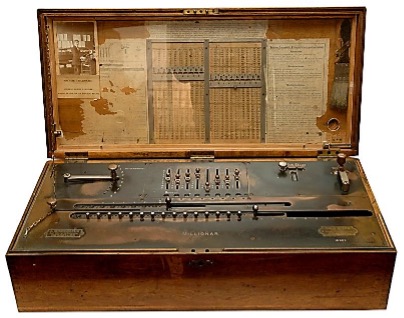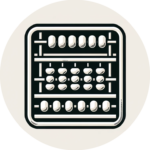MILLIONÄR, 1892
Inventor
Otto STEIGER de Saint Gall (1858-1923)
Invention date
1892 (German patent DE 72870)
Manufacturing date:
1896 to 1935
Manufacturing location
Zürich, Switzerland
Manufacturer
H.W. EGLI
Dimensions
L 67 H 20 W 31 Weight 40kg
Reference Number
012

History and Functionality
Otto STEIGER, Swiss engineer, invented in 1892 a new mechanism that allows for the direct multiplication of a number by a digit. This mechanism uses a plate containing rods of length proportional to the terms of the columns of the multiplication table. Its purpose is not to break down any longer a multiplication into additions but to go direct.
The “Millionaire” is a significant improvement in the speed of multiplication and division. With this machine, simply set the number of the multiplicand, choose one figure of the multiplier and turn the crank once. The multiplication of 325 x 26 requires only two rotations of the crank while decomposition into additions would need 8.
This machine was a real commercial success (exchange offices, banks, insurance companies) despite its high price (for example in the United States, in the early 20th century, the machine sold for $475 up to $1,100. This corresponded to the price of a car). Production lasted 44 years from 1893 to 1937, during which 4,655 machines were made.
The “Millionaire” is credited with an historical calculation. Around 1905, William PICKERING and Percival LOWELL’s hypothesis was that irregularities in the orbit of Neptune could be due to another unknown planet. To make the all the necessary calculations, PICKERING had used a “Millionaire” and published a prediction in 1908.
About The Inventor
Otto Steiger, born in 1858 in Saint Gall, Switzerland, was an inventive figure in the history of computational technology. He is most renowned for his invention of the “Millionaire” calculating machine, a groundbreaking development in the early 20th century. The Millionaire, introduced in 1893, was one of the first calculating machines that could perform direct multiplication, a significant advancement over the existing adding machines of that era which could only do multiplications through repeated additions.
This innovative machine drastically reduced the time and effort required for complex calculations, making it a valuable tool in scientific, engineering, and financial computations. The Millionaire was unique in its ability to perform multiplication with a single turn of a crank for each digit in the multiplier, a feature that set it apart from other calculators of its time. Its ease of use and efficiency made it a popular choice among professionals and it enjoyed widespread use until the mid-20th century when electronic calculators began to emerge.
Otto Steiger’s contribution through the Millionaire calculator represented a significant leap in the field of mechanical computation. His invention not only simplified mathematical operations but also laid important groundwork for the development of future calculating devices, marking an essential milestone in the transition from manual to automated computation.
Steiger’s work exemplifies the innovative spirit and technological advancement of the early 20th century, highlighting the period’s contributions to the evolution of computing.

